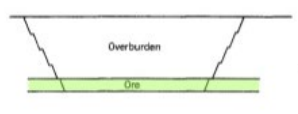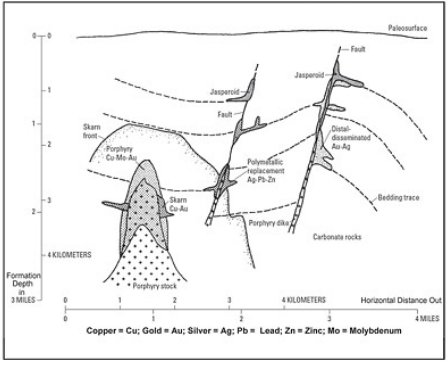Metallic ores
ferrous metals, base metals, precious metals, radioactive minerals
ferrous metals
(iron, manganese, molybdenum, and
tungsten
base metals
copper, lead, zinc, and tin
precious metals
gold, silver, the platinum group metals
radioactive minerals
uranium, thorium, and radium
Nonmetallic minerals
the nonfuel mineral ores that are not associated with the production of metals. These include phosphate, potash, halite, trona, sand, gravel, limestone, sulfur, and many others.
Fossil fuels
the organic mineral substances that can be utilized as fuels, such as coal, petroleum, natural gas, coalbed methane, gilsonite, and tar sands.
Ore Body
accumulation of a solid and fairly continuous mass of
ore with
gangue, distinctly distinguishable by form and
character from the
enclosing host rock

Tabular, flat, sheets – bedding planes

Lenticular/lensoid, podiform

Cylindrical/Pipes/chimneys

Irregular, disseminated

Veins
Syngenetic ores
Primary
mineralization;
- ores form at the
same time
as the
host rock
Epigenetic ores
Secondary
mineralization;
- ores concentrate
some
time* after
the rock has
formed
Magmatic
(Chromite, Nickel-copper and PGE’s) and Diamonds
originate by the aggregation of the desired
mineral
particles or crystals at one or several stages
during
the cooling and solidifying of molten rock.
Hydrothermal
ore constituents (e.g. Cu, Pb, Au, etc.) are dissolved in a hot aqueous solution along with other deposit constituents (e.g. Si, S, Fe)
Most Common source for minerals in the Philippines
Hydrothermal
Supergene enrichment
surface waters percolate downward
Hypogene Enrichent
- a process that occurs as deep, upwelling magmatic fluids concentrate ore minerals in the crust
Skarn
Gold
Surficial
originate from surface or near-surface processes
Latherite
Surficial (Mostly Ni and Fe)
Limonite
More Fe less Ni
Saprolite
More Ni Less Fe